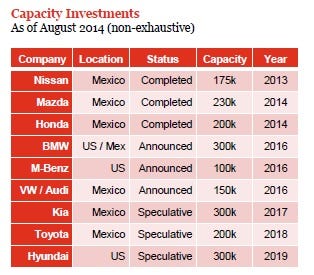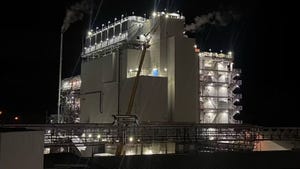Mexico emerging as key player in NAFTA auto sector: from German, Korean and Japanese transplants at the fore
An analyst note recently released by PwC Autofacts highlights the growing role of Mexico in the manufacture of light vehicles for the NAFTA zone. Autofacts anticipates that non-NAFTA light vehicle imports, as a percentage of total sales, will steadily decline as the capacity investments in Mexico come online.
October 8, 2014
An analyst note recently released by PwC Autofacts highlights the growing role of Mexico in the manufacture of light vehicles for the NAFTA zone. Autofacts anticipates that non-NAFTA light vehicle imports, as a percentage of total sales, will steadily decline as the capacity investments in Mexico come online.
Amid the recession in 2009, non-NAFTA imports peaked at just over 26% of US light vehicle sales, driven by a depleted domestic assembly base and a sharp increase in demand for small, fuel efficient vehicles that were largely supplied from overseas according to Autofacts. This ratio has steadily declined to the point whereby through the first half of 2014, non-NAFTA imports comprised around 21.1% of US light vehicle sales.
|
Eight more auto assembly lines for Mexico between 2013 and 2020. |
Looking ahead, this trend is expected to accelerate thanks in large part to the reemergence of Mexico as a prime assembly base. While the country still offers a relatively low-cost labor force and open access to the US and Canadian markets via NAFTA, it also boasts a developed supply base along with free trade agreements with a number of other Latin American countries and other markets overseas notes Autofacts.
Another important consideration that vehicle assemblers have taken into account is foreign exchange volatility, which can have a significant impact on a company's profits. Indexed against the US Dollar ($) from 2000 , the Euro (€ ), Korean Won (â‚©) and Japanese Yen (¥) have all gained in value during the same period. Considering that over 91% of non-NAFTA imports came from Germany, South Korea and Japan in 2013, it is in the best interest of these OEMs to localize production within the region in order to minimize the impact of currency fluctuation.
As a result, no fewer than eight announced or forecasted vehicle assembly plants are expected to come online in Mexico between 2013 and 2020 , all from German, Korean and Japanese OEMs, representing over 2 million units of added capacity. While the majority of this volume is expected to be sold within North America, there are also plans to export an increasing number of vehicles abroad from both existing and planned facilities.
You May Also Like



